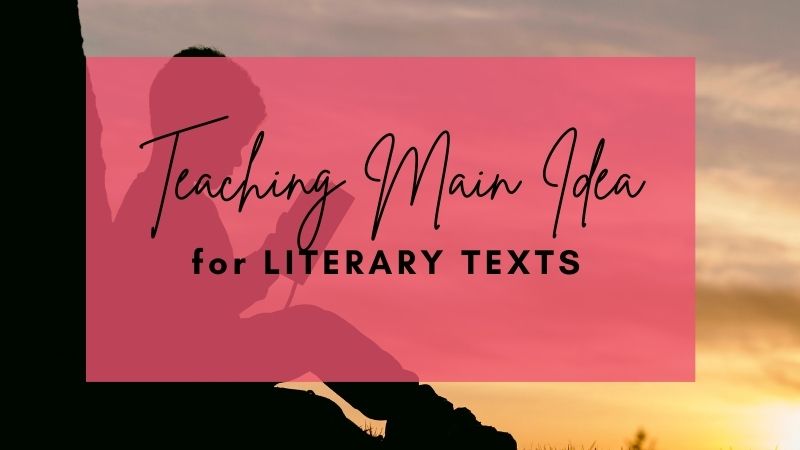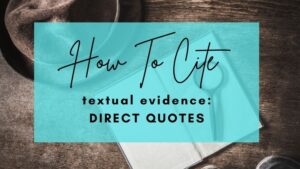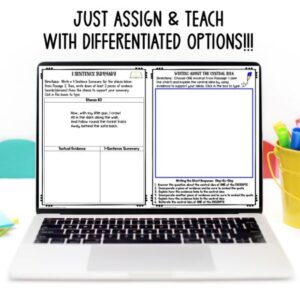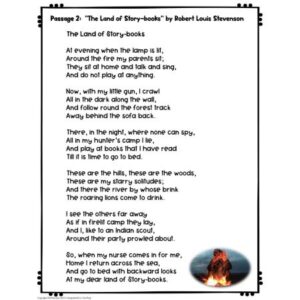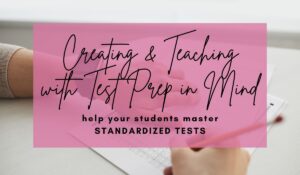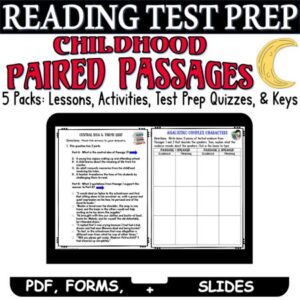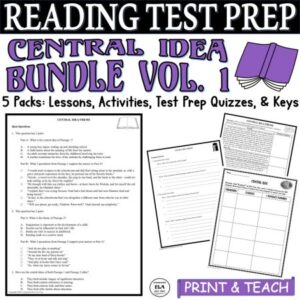Teaching main idea is no easy feat. On the surface, it appears simple. You read a passage: a poem, short story, news article, etc.
Then, you ask yourself? What is the main idea of a passage? For most of us, this task may seem effortless. You know the topic and basic gist.
However, for most of our students, determining the main idea or central idea remains a mystery. If your students are anything like mine, they need to constantly focus on the main idea/central idea of a passage, no matter how easy or difficult the passage is!
Keep reading for ideas that will help your student answer What is the Main Idea of a Passage?
Need help with Test Prep and answering the following question: What is the main idea of a passage? Check out this FREE Pack of 3 Test Prep Activities to help students achieve success on standardized tests!
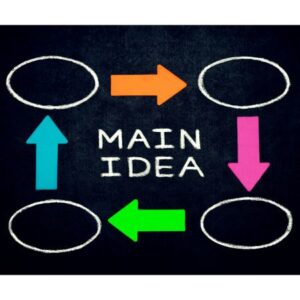
Why is teaching how to answer the question “What is the main idea of a passage?” so hard?
Reading is a complex process. Students not only have to know most of the words in a passage to be able to understand a text, but they also have to comprehend tone, purpose, words that have multiple meanings, and context. Additionally, background knowledge is incredibly helpful. So, when it comes to asking “What is the main idea?” for just about every text, the answer is not so straightforward.
I guess this is why it bothers me so much when people say that all our students have to do is read and answer the questions. What’s so hard about it? Reading, like any discipline, takes time, determination, and tons and tons of practice. As teachers, we must provide these opportunities in EVERY subject we teach. Even if you are not a reading teacher, your students need to be able to read to be successful…even in math, or should I say, most especially in math. Have you read a word problem lately? Oh my goodness!
After answering the question What is the Main Idea of a Passage?, do you need help with teaching CITING EVIDENCE? Check out this post here>>> How To Cite Textual Evidence: Direct Quotes
6 Questions that lead students to the Main Idea
1. What is the topic of the passage? Be specific.
You would be SHOCKED, or maybe you wouldn’t be, at how many students struggle with merely discerning the topic or subject of a passage. The other day I had a student read 2 texts, an advertisement and a speech, about voluntourism (volunteering while visiting another country as a tourist). When I asked about both passages, the student first could not tell that the passages were different. Furthermore, he could not tell me the topic of the paired texts.
Instead, I got a roundabout response that they were about volunteering. Um, no. They are not about volunteering, even though the words are similar. Specificity is key when responding to “What is the main idea of a passage?”!
Here is a quick activity to help students with specificity when contemplating “What is the main idea of a passage?”:
Play “What is more specific?” See examples below.
- Positive> (ex. peaceful, calm, happy, ecstatic)
- Negative> (ex. upset, sad, downhearted, melancholic)
- Restaurant> (ex. fast food, chicken sandwich place, Chick-fil-A)
- Song> (ex. religious melody, hymn, “Amazing Grace”)
Check out the test prep bundle below for help with teaching reading comprehension standards that include this question: What is the main idea of a passage?
2. What can we look at to determine the main idea of the passage?
To help our students as they consider “What is the main idea of a passage?”, we can look at several things:
- Title: Yes, titles are vital to figuring out the main idea. Who knew?
- Author: Sometimes, there will be a blurb about the author. Make sure to point it out when you can.
- Images: Pictures are not there so you have something else to look at. They have a purpose.
- Repetitive Words/Phrases: This is a big one! Any time a word or phrase is repeated, it is important.
- Structure: How a text is organized can be so helpful. Just skimming the first and last part of a paragraph or passage can help reinforce meaning.
Let’s apply this process (“What is the main idea of a passage?”) to the poem “The Land of Story-books” by Robert Louis Stevenson found in Paired Passages Childhood Central Idea Lesson Pack!
- Title: “The Land of Story-books” (Okay…this poem is probably about stories in books.)
- Author: Robert Louis Stevenson (I don’t see much else.)
- Images: I see a person waving arms around a fire. (Perhaps, this story will involve a fire for some reason.)
- Repetitive Words/Phrases: “fire,” “sit,” “books,” “bed,” “these are” (Clearly, this speaker is focused on different locations; however, he/she also mentions books and having to go to bed.)
- Structure: The speaker starts off by describing how his/her parents are not playing at night. At the end of the poem, a nurse comes to take the speaker away to bed far from his/her books. (One can see that the speaker enjoys his/her playtime and her/his books and does not want to go to bed.)
Do you want to prepare your students for standardized tests and teach good solid literature at the same time? Read here>>> Reading Comprehension High School Worksheets: Creating and Teaching With Test Prep In Mind
3. Why did the author write this passage?
I fully believe that literature as well as informational texts have a purpose. There is always a point of exigence that spurred the author towards creation. We need to figure out the purpose and then the ultimate message. Purpose is just as difficult to pinpoint as the main idea; however, hypothesizing with the student can help. Be sure to incorporate the topic and what you discovered by looking at the passage.
Here are some author’s purpose + theme (message) related statements that could or could not be true based on the poem above:
- to share a story about a kid who loves reading and acting out adventures
- to relay an important message that people should value books
- to argue that kids should stay at home with their parents every night
- to encourage families to read together
- to support the idea that books help children’s imaginations
The main idea is different from the author’s purpose, but they are intertwined. Knowing how to answer “What is the main idea of a passage?” is vital to understanding the overall purpose of any text!
4. What is this passage NOT about?
This might be a fun activity for students. You could have students write down what the passage is NOT about, mix their responses with true statements, and play a game! Students could work together or in teams to decide what the passage is really about.
Here is a sample central idea question (“What is the main idea of a passage?”) with answers!
What is the central idea of Passage 1? / What is the main idea of a passage?
A. A young boy enjoys waking up and attending school.
B. A child learns about the meaning of life from his mentor.
C. An adult recounts memories from his childhood involving his tutor.
D. A teacher transforms the lives of his students by challenging them to read.
5. What evidence from the passage connects to the topic?
Most kids start the annotation process with a big yellow highlighter. By the end of the highlighting process, almost the entire page is highlighted…except for like 1 or 2 sentences. We’ve all been there. Instead, maybe we could have students focus on only the threads (evidence) that connect to the main topic. Limiting the highlighting will help! You could tell them to only highlight 3 words, 2 phrases, and 1 sentence from each paragraph or passage.
Here is an example that encourages students to focus on 2 pieces of evidence when responding to “What is the main idea of a passage?”
6. What is the main idea of a passage in 1 sentence ONLY?
I love having students create 1 sentence summaries! This process forces the student to become super specific. It is a fairly easy equation.
TOPIC + MEANING (message or purpose) = MAIN IDEA
It makes answering the following question easy: “What is the main idea of a passage?”
Let’s look at this activity from Paired Passages About Childhood Central Idea Lesson Pack with a focus on What is the main idea of a passage?
Click here to JOIN my email list for more reading comprehension ideas and to download “13 Effective Ways To Integrate Test Prep Into Your Classroom!”
Why do we need to keep teaching main idea at ALL times?
If a student is not consistently comprehending the main idea, the text itself has no purpose. If people in general cannot understand a passage, the writer has not achieved his/her goal.
When our students leave us, they will enter a world filled with texts they will consume either by listening, watching, or reading. They need to be prepared to keep reading and rereading, so they understand and navigate the world around them. And it all starts with the question: “What is the main idea of a passage?”
How many times has a high school graduate signed up for a student loan without reading, let alone understanding the contract? How often have you heard of someone who chose a specific type of insurance and thought he/she was covered only to owe the hospital thousands of dollars? And how have you felt clicking on and perusing a news article only to find that the headline was merely click-bait?
These situations happen all of the time. This is why we teach reading and how to attack answering “What is the main idea of a passage?”. Ultimately, we as readers know that it takes time, determination, and tons and tons of practice, but the outcome for our students can be life-changing!
Need more help with pre-made lessons, activities, quizzes, and answer keys that help answer the question “What is the main idea of a passage?” Check out my store Kristin Menke-Integrated ELA Test Prep!
CENTRAL IDEA RESOURCES
Do you need a SIMPLE and EASY solution to help your students prepare for standardized tests?
This Reading Comprehension Passages and Questions Test Prep CENTRAL IDEA / THEME Lesson BUNDLE prepares upper middle and high school students for state reading comprehension exams and assessments (with informational texts, literary texts, and paired passages)!!
Click here to JOIN my email list for more reading comprehension ideas and to download “13 Effective Ways To Integrate Test Prep Into Your Classroom!”

